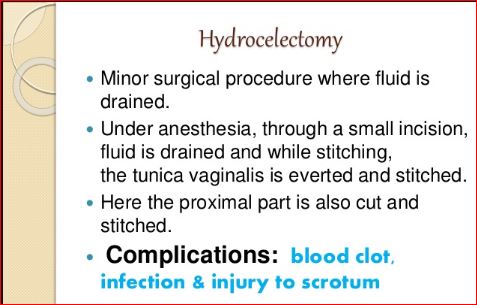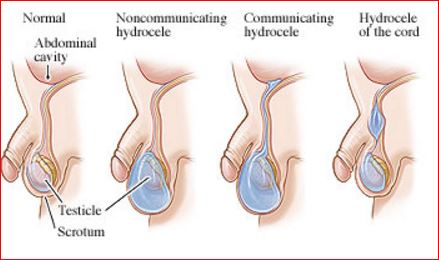What is Hydrocelectomy?
Hydrocelectomy is a surgical procedure performed to get rid of a hydrocele or repair it. A hydrocele is a sac that is filled with fluid and surrounds the testicle. This fluid-filled sac can cause swelling in the pouch holding testicles, also known as scrotum.
It may be quite scary to have hydroceles because they form in a sensitive area of the body and are visible. Although mostly these fluid sacs are painless and go away without the need for treatment, when there is swelling occurring in scrotum, it may require removal by surgery. This is what is referred to as hydrocelectomy.

Causes
A hydrocele forms around a testicle and is common among babies. The Urology Care Foundation points out that close to 10 percent of males at the time of birth have a hydrocele. But, these hydroceles can affect males after birth in any age.
While hydroceles don’t cause pain or pose any threat to your testicles, if there is scrotal swelling occurring, it is important you consult a doctor just to make sure that the swelling isn’t being caused by another serious condition like testicular cancer.
When a baby is about to be born during the end of pregnancy, the testicles of a male child descend from the baby’s abdomen and move to the scrotum, which is a sac of skin meant to hold the testicles after they descend. When a baby is born, during development, there is a sac surrounding each testicle and these sacs contain fluids in them.
Usually, the sacs will close themselves and the fluid in them is absorbed by the body. This happens during the first year of life of the baby. In babies with hydroceles, the sacs do not close.
A hydrocele may also form sometimes later in life. It mostly occurs in men who are over 40 years. Usually, this happens when the passages through which testicles descend did not close entirely or they reopened.
If the channels haven’t closed, fluid moves from abdomen area and enters the scrotum. That fluid may cause swelling in scrotum. Other times, an injury or inflammation occurring in the scrotum due to an infection such as epididymitis may cause the scrotum to swell.
Diagnosis
In diagnosing hydroceles, a doctor will perform the following:
- A physical exam by a doctor helps determine if it is a case of hydrocele or another condition like testicular torsion. With hydrocele, it is not usually painful, but testicular torsion is very painful and tender. A flashlight is shined through scrotum to show the outline of testes and it may suggest hydrocele.
- A doctor may use ultrasound device to help confirm the diagnosis.
- Blood and urine tests may be ordered to determine if there may be an infection or inflammation.
Treatment
There are two approaches to treating a hydrocele and they are: Aspiration and Surgery.
Aspiration
In this type of treatment, it involves sucking the fluid using a needle. A doctor inserts the needle into the child’s scrotum and moves it to the hydrocele. While sucking the fluid may remove it, it may not be a permanent solution because it is likely that the condition will reoccur when the fluid in abdomen moves again to fill the sac.
Again, aspiration presents higher risk of infection. Sometimes, a doctor may use medications to work alongside the aspiration, and this may produce somewhat long-term results.
Surgery
A surgical repair or removal of a hydrocele gets rid of it and prevents recurrence. This method is preferred in children who have reached 2 years. It is also the preferred treatment method for hydroceles in adults.
Surgery is opted if the hydroceles have enlarged and are beginning to be painful. If after aspiration, the hydroceles have reoccurred, then surgery is deemed the standard practice. 2

Performing
Typically, hydrocelectomy is done on an outpatient basis. A general anesthesia is given before the surgery. The nature and extend of surgery will depend on any other problems the patient may have. If the hydrocele is not complicated, an incision is made directly into the scrotum.
When the channel or canal between the abdomen and scrotum is repaired, then hydrocele sac is removed. The fluid is removed and the doctor closes the incision with sutures.
Should there be complications, a doctor can address them at the same time. For example, if there is an inguinal hernia, the doctor makes an incision in groin area to repair the hernia and at the same time correct the hydrocele.
How to Prepare for the Surgery?
Before the surgery, you will need to tell your doctor if there are medications you are taking including herbs and blood thinner such as clopidogrel, aspirin, and warfarin. The doctor may recommend that you stop taking these medications. You may also be asked to not eat or drink anything before the surgery.
Day of Undergoing Surgery
Just before the surgery is performed, the surgeon begins by administering an IV line to deliver medications like antibiotics and other fluids. You are then administered the anesthesia to numb the pain when the surgery is being performed.
A local anesthesia or some numbing medicine may be administered to help in managing pain after the surgery.
Surgery
The steps involved in the surgery are:
- A surgeon making an incision or small cut in the scrotum or at times in the groin just close to scrotum and draining out the fluid using a suction
- Surgeon closing the channel or canal that allows communication or passage of fluid from abdomen cavity to scrotum
- The surgeon removing the hydrocele sac and closing the incision
- Repairing any other complication present like hernia.
After the Surgery
When the surgery has been done, you are taken to recovery room to recover from the anesthesia. A physician or nurse will ensure that you are not in pain. Sometimes, you may feel nauseated and sleepy. A breathing tube may have been used and if that is the case, you will have soreness at the throat.
The surgical area may be numbed using an ice park to reduce swelling. A jockstrap to help in relieving the pain and swelling may be given to you. The jockstrap also prevents injury. When the doctor feels that you are ready to go home, a family member or friend will drive you home.
The procedure takes about 30 to 45 minutes and you could be discharged the same day.
Tips
Your doctor or surgeon will give you instructions that you have to follow to ensure quick recovery at home. During recovery, these tips can help you:
- Use cold compress or ice packs applied to the scrotum as you have been directed to reduce swelling. You may want to do this for about 15 minutes every time and this continues for about 2 days or until the swelling subsides
- If you have been prescribed pain medications, take them as directed
- Ensure that the incision is protected and not exposed to any kind of harm or injury
- Follow the instructions for showering. You will need to refrain from bathing, swimming, or using hot tub. You also need to do away with any activities that may make the incision to be exposed to water until that time the doctor will say it’s okay.
- You will need to wear snug underwear or jockstrap as you have been directed
- Refrain from doing strenuous exercises or heavy lifting
- Don’t indulge in sex for a period of about 4 weeks
- Refrain from driving until you finish taking the pain medications or until the doctor says now you can drive
Complications of Surgery
While a surgeon will do everything possible to ensure that there are no serious complications, you may need to call your doctor if you experience one or more of the following after-surgery complications:
- You have chest pain or experiencing trouble breathing
- Experience fever of 38 degrees Celsius or higher
- You notice symptoms of an infection at the site of incision, for example, increased swelling, redness, worsening pain, warmth, or foul smelling drainage
- Increased swelling or pain coming from the groin or scrotum
- Pain that gets worse or is not relieving after taking pain medicines
- Bleeding coming from the site of incision
Reference List
- https://myhealth.alberta.ca/Health/aftercareinformation/pages/conditions.aspx?hwid=ug5522
- https://my.clevelandclinic.org/health/articles/hydrocelectomy
- http://www.surgeryencyclopedia.com/Fi-La/Hydrocelectomy.html
- https://www.saintlukeshealthsystem.org/health-library/hydrocele-surgery-hydrocelectomy
- Hydrocelectomy. Available at http://austinurologyinstitute.com/procedures/hydrocelectomy/
- Hydrocele. Available at http://www.healthline.com/health/hydrocele#overview1
